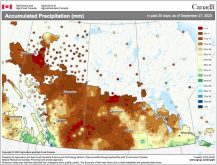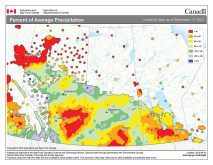Last weekend, while we were waiting for the Riding Mountain Triathlon to start, a thunderstorm rolled through the region, forcing everyone to run for shelter. Two weather-related story ideas came to me while waiting for the storm to move out and the race to begin. The first I’ve already talked about in the past: safety and thunderstorms. I couldn’t believe how many people took refuge under the big pine trees adjacent to the beach! I was just waiting for the worst to happen, but luckily it didn’t. The second idea is something with which I’ve been playing around for a while now, but I still haven’t figured out how to properly broach the subject. During the storm I overheard a number of weather conversations, and one in particular grabbed by attention. It had to do with something I refer to as “now forecasting.” During the storm someone mentioned that the forecast said the rain or thunderstorms weren’t supposed to arrive until 1 p.m. This “now forecasting” is a trend that several forecasters have added to their weather apps. These break the forecast down into hourly time frames, with some even adding in estimates of when rain or storms may arrive, down to the minute, based on radar trends. For those of you who follow the weather closely, you know that getting a general 24-hour-period forecast correct is tough; trying to predict things on an hourly basis, is, in my opinion, verging on insanity. Sometime over the next month or two I’ll figure out a way to look into this topic in more detail.
Read Also

Thunderstorms and straight-line winds
Straight-line winds in thunderstorms can cause as much damage as a tornado and are next on our weather school list exploring how and why severe summer weather forms.
For this issue I said we’d begin our look into El Niño, just what it is and what impact might it have on our weather. Well, to put it simply, El Niño is a change in ocean surface temperatures across the tropical and subtropical Pacific Ocean. This change in ocean temperatures then creates a change in the weather patterns across the Pacific Ocean. Now, the big question is, why would a change in weather over the Pacific Ocean have an impact on us?
The first and most simple reason, is that the Pacific Ocean just happens to cover half of our planet, so any large-scale change in it is bound to have an impact elsewhere. Actually, maybe it’s not that simple. Even though the Pacific Ocean is huge, why should changes in weather in that area of the world impact us? Keeping in mind just how big the Pacific is, let’s now look at what the Pacific Ocean is made of — could it be water? Lots and lots of water!
Our big heat battery
OK, so the Pacific Ocean is really big and it is made of water, but that still doesn’t explain why changes in it affect the weather way over here. To really understand why, we need to remember it takes a whole lot of energy to warm water up, and conversely, water releases a whole lot of energy when it cools down. In essence, water is like a battery that stores heat; therefore, the Pacific is like a really big heat battery.
From a general point of view, weather is the atmosphere’s attempt to equal out heat imbalances. You see, just like most of us, the atmosphere likes things to be equal. If there is too much heat in one place or too much cold in another, the atmosphere tries to make things equal by sending cold air southward and warm air northward. The tropical areas of our planet rarely, if ever, see or feel cold air trying to move southward. If you live in the Arctic regions, you would rarely, if ever, see the really warm air try to move northward. For those of us in the middle, we are constantly feeling and seeing this movement of cold and warm air — and we call it weather.
Now, back to the Pacific Ocean, our big heat battery. If the Pacific is storing up heat and releasing it into the atmosphere, that heat energy has to go somewhere. Some of it simply warms the air, but then the atmosphere wants to equal out that warm air, so off that warm air goes. A big chunk of the heat energy coming out of the Pacific goes into developing clouds, precipitation and storm systems. These storm systems are an efficient way for the atmosphere to move heat around and equalize it, because you can move a lot more energy by moving warm water around (remember, clouds are made up of water) than you can by moving warm air.
This overall movement of warm air and storm systems over the Pacific Ocean creates a general pattern of winds around the world. If you remember back to our articles about general atmospheric circulation, we know the general movement of air around the planet comes about by the Earth trying to equal out warm and cold regions, and this creates the westerly winds in our region of the world, the tropical easterlies to our south and, finally, the polar easterlies in the high Arctic.
Under normal temperature conditions across the Pacific, the general flow of the atmosphere follows this simple pattern, and since a large portion of our weather comes off of the Pacific (because we live in the generally westerly flowing part of the atmosphere) our weather tends to be rather average. If we change the amount of heat over a large portion of the Pacific, either by warming up the Pacific Ocean (El Niño) or cooling it down (La Niña), this disrupts the general flow of air across this region and can start to impact how the air flows across our region.
Next time we’ll take a closer look at exactly what happens over the Pacific to allow El Niño to form, and examine how these events are classified.



















